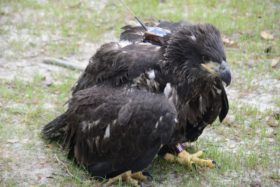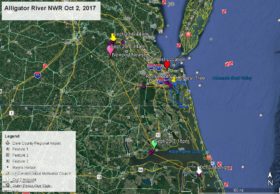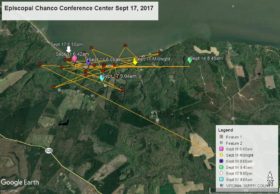Bald Eagle Fledging Time
Yep! – Azalea Is Back Eating Catfish
June 3, 2011Camellia Still at Inlynnview in Va Beach
June 6, 2011



It is the time of year when bald eagles in Virginia are fledging their young. Last week, this week and the next two weeks the vast majority of new bald eagles will take to the air for the first time – called fledging. These are photos I took today June 4, 2011 in Virginia Beach, VA on the Lynnhaven River of two adults – female and then male, and their two eaglets who left their nest tree for the first time this week. Note the very white tail of the fledgling in 3rd photo. He will be easy to identify. I believe both fledglings are male.
Today they were doing what juvies do best their first few days out of the nest – calling loudly for food- called food begging. They and I got to watch dad catch two fish and sit on a pole in the water and eat both fish. They have got to learn to do that for themselves! The adults have fed them at the nest the past couple days, but will not do that much longer. It will quickly be up to these youngsters to catch their own food.
Photos copyright of Reese F Lukei Jr




18 Comments
Awesome series of photos, Reese…and what a joyous time of year in Virginia. Thanks for posting
What great news, Reese. This is all so fascinating. Thanks for keeping us up to date! Didn’t even realize there was a nest in Virginia Beach. Are there other nests in Hampton Roads?
Response – Yes over 20 BE nests
GORGEOUS!!! Love the symmetry of the white on both young ‘uns. Thanks for posting!! We eagerly await watching “our babies” fly too.
Reese, what gorgeous juvies! I am fascinated by the coloration and pattern variation of young eagles. Seeing them is my most favorite thing! Thanks for everything!
Reese, thank you for sharing these pictures. It looks like to me that this male has a broken wing feather on his right wing similar to NBG male which i believe his broken wing feather is on his left wing. Just an observation.
response. you are right. New one is growing in.
wow – 2 looking great – flying well Glad you had a blue sky too
Thanks
Wow, great pictures – they are all beautiful. Thanx for sharing, Reese.
What beautiful photos! First time I have ever really seen the underside so perfectly when they are flying!
Hello Reese. Great pictures and good timing that you were able to get the whole family. The ‘youngsters’ look good. You ‘re so lucky to live in an area that you are able to see all of this. Color me green with envy.
Thank you for sharing this with us.
WOW!! If the NBG eaglets had been able to have the adults and stay in the nest, would we be looking at this scene (if we COULD) in the next week or two? Two have fledged at WCV, NX not as far as we know yet.
I am looking forward to 3 healthy NBG eaglets soaring like this… and wishing them well.
Thanks for popping in and sharing on the blog!! We miss you a lot, but know you are busy. Thanks so much!!!
OK if it’s not raining tomorrow morning I’m going over there first thing!! It was frustrating this afternoon being able to hear them but not see them!! Thanks as always for the updates!
Thanks for posting this set of pics, Reese! Really nice to see a healthy pair of juvies and their parents like that, and great comparison overhead of male and female.
Mr. Lukei,
How are the 4 eaglets at James River doing if you know? Thank you…Pam
Response – They are to be checked on this week.
Thank you so much for sharing these…and th ankyou so much for sharing your knowledge and passion for these extraordinary birds…
beautifil pics Reese. thank you so much for posting. what a splendid time of year for you all. I have learned so much from our “eagle nation”. keep an eye to the sky =)
The pictures are terrific. I envy you getting to see this beautiful sight! Thanks for sharing with us!
Terrific photos! So helpful for me to see the difference between the adult and juvenile in flight. Great time to be out there in Virginia!! Maybe next year for me. Thanks for all your updates and work!
Excellent photos!
How will the NBG eaglets learn to hunt for their own food without the guidance of watching the adults?
Response – It is my understanding that these eagles will be released in an area known to have other eagles. They will have to learn from these experienced eagles – adults and juveniles.